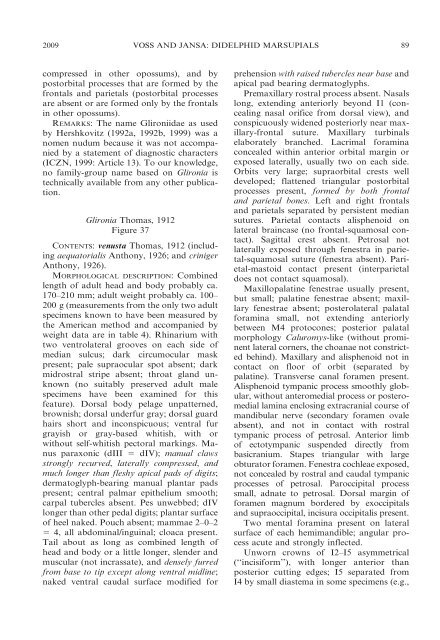phylogenetic relationships and classification of didelphid marsupials ...
phylogenetic relationships and classification of didelphid marsupials ...
phylogenetic relationships and classification of didelphid marsupials ...
You also want an ePaper? Increase the reach of your titles
YUMPU automatically turns print PDFs into web optimized ePapers that Google loves.
2009 VOSS AND JANSA: DIDELPHID MARSUPIALS 89<br />
compressed in other opossums), <strong>and</strong> by<br />
postorbital processes that are formed by the<br />
frontals <strong>and</strong> parietals (postorbital processes<br />
are absent or are formed only by the frontals<br />
in other opossums).<br />
REMARKS: The name Glironiidae as used<br />
by Hershkovitz (1992a, 1992b, 1999) was a<br />
nomen nudum because it was not accompanied<br />
by a statement <strong>of</strong> diagnostic characters<br />
(ICZN, 1999: Article 13). To our knowledge,<br />
no family-group name based on Glironia is<br />
technically available from any other publication.<br />
Glironia Thomas, 1912<br />
Figure 37<br />
CONTENTS: venusta Thomas, 1912 (including<br />
aequatorialis Anthony, 1926; <strong>and</strong> criniger<br />
Anthony, 1926).<br />
MORPHOLOGICAL DESCRIPTION: Combined<br />
length <strong>of</strong> adult head <strong>and</strong> body probably ca.<br />
170–210 mm; adult weight probably ca. 100–<br />
200 g (measurements from the only two adult<br />
specimens known to have been measured by<br />
the American method <strong>and</strong> accompanied by<br />
weight data are in table 4). Rhinarium with<br />
two ventrolateral grooves on each side <strong>of</strong><br />
median sulcus; dark circumocular mask<br />
present; pale supraocular spot absent; dark<br />
midrostral stripe absent; throat gl<strong>and</strong> unknown<br />
(no suitably preserved adult male<br />
specimens have been examined for this<br />
feature). Dorsal body pelage unpatterned,<br />
brownish; dorsal underfur gray; dorsal guard<br />
hairs short <strong>and</strong> inconspicuous; ventral fur<br />
grayish or gray-based whitish, with or<br />
without self-whitish pectoral markings. Manus<br />
paraxonic (dIII 5 dIV); manual claws<br />
strongly recurved, laterally compressed, <strong>and</strong><br />
much longer than fleshy apical pads <strong>of</strong> digits;<br />
dermatoglyph-bearing manual plantar pads<br />
present; central palmar epithelium smooth;<br />
carpal tubercles absent. Pes unwebbed; dIV<br />
longer than other pedal digits; plantar surface<br />
<strong>of</strong> heel naked. Pouch absent; mammae 2–0–2<br />
5 4, all abdominal/inguinal; cloaca present.<br />
Tail about as long as combined length <strong>of</strong><br />
head <strong>and</strong> body or a little longer, slender <strong>and</strong><br />
muscular (not incrassate), <strong>and</strong> densely furred<br />
from base to tip except along ventral midline;<br />
naked ventral caudal surface modified for<br />
prehension with raised tubercles near base <strong>and</strong><br />
apical pad bearing dermatoglyphs.<br />
Premaxillary rostral process absent. Nasals<br />
long, extending anteriorly beyond I1 (concealing<br />
nasal orifice from dorsal view), <strong>and</strong><br />
conspicuously widened posteriorly near maxillary-frontal<br />
suture. Maxillary turbinals<br />
elaborately branched. Lacrimal foramina<br />
concealed within anterior orbital margin or<br />
exposed laterally, usually two on each side.<br />
Orbits very large; supraorbital crests well<br />
developed; flattened triangular postorbital<br />
processes present, formed by both frontal<br />
<strong>and</strong> parietal bones. Left <strong>and</strong> right frontals<br />
<strong>and</strong> parietals separated by persistent median<br />
sutures. Parietal contacts alisphenoid on<br />
lateral braincase (no frontal-squamosal contact).<br />
Sagittal crest absent. Petrosal not<br />
laterally exposed through fenestra in parietal-squamosal<br />
suture (fenestra absent). Parietal-mastoid<br />
contact present (interparietal<br />
does not contact squamosal).<br />
Maxillopalatine fenestrae usually present,<br />
but small; palatine fenestrae absent; maxillary<br />
fenestrae absent; posterolateral palatal<br />
foramina small, not extending anteriorly<br />
between M4 protocones; posterior palatal<br />
morphology Caluromys-like (without prominent<br />
lateral corners, the choanae not constricted<br />
behind). Maxillary <strong>and</strong> alisphenoid not in<br />
contact on floor <strong>of</strong> orbit (separated by<br />
palatine). Transverse canal foramen present.<br />
Alisphenoid tympanic process smoothly globular,<br />
without anteromedial process or posteromedial<br />
lamina enclosing extracranial course <strong>of</strong><br />
m<strong>and</strong>ibular nerve (secondary foramen ovale<br />
absent), <strong>and</strong> not in contact with rostral<br />
tympanic process <strong>of</strong> petrosal. Anterior limb<br />
<strong>of</strong> ectotympanic suspended directly from<br />
basicranium. Stapes triangular with large<br />
obturator foramen. Fenestra cochleae exposed,<br />
not concealed by rostral <strong>and</strong> caudal tympanic<br />
processes <strong>of</strong> petrosal. Paroccipital process<br />
small, adnate to petrosal. Dorsal margin <strong>of</strong><br />
foramen magnum bordered by exoccipitals<br />
<strong>and</strong> supraoccipital, incisura occipitalis present.<br />
Two mental foramina present on lateral<br />
surface <strong>of</strong> each hemim<strong>and</strong>ible; angular process<br />
acute <strong>and</strong> strongly inflected.<br />
Unworn crowns <strong>of</strong> I2–I5 asymmetrical<br />
(‘‘incisiform’’), with longer anterior than<br />
posterior cutting edges; I5 separated from<br />
I4 by small diastema in some specimens (e.g.,

















